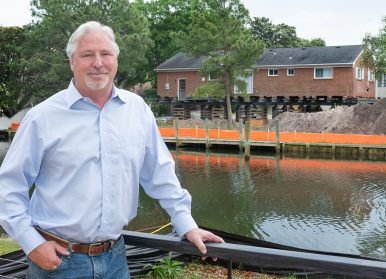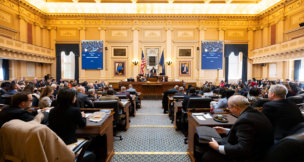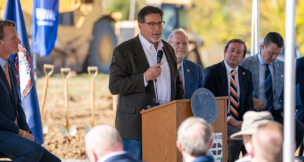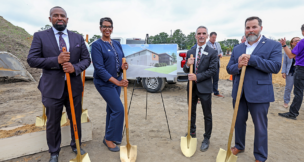The ripple effect
National flood insurance changes are being felt statewide

Tidal flooding filled Norfolk streets in early October 2022. Photo by Jim Morrison/The Washington Post via Getty Images

Tidal flooding filled Norfolk streets in early October 2022. Photo by Jim Morrison/The Washington Post via Getty Images
The ripple effect
National flood insurance changes are being felt statewide
Major storms year-round are bringing an increased risk of flooding to the doorsteps of property owners across Virginia, but changes in the market for flood insurance could mean some will be ill-prepared when the water rises.
Some inland Virginians have learned firsthand in recent years about the devastating toll of flooding, which has long been a reality in Hampton Roads. There, shoreline erosion threatens properties on the water, while hurricane season is always fraught.
With the exception of 2003’s Hurricane Isabel, coastal Virginia has avoided a direct hit from the nearly 100 hurricanes that have made landfall in the continental U.S. during the past 60 years. The 2024 Atlantic hurricane season will once again test whether that streak can continue.
“I don’t like to cry wolf, but we’ve been really lucky for a long time,” says Michael Vernon, founder and CEO of Flood Insurance Hampton Roads, based in Virginia Beach. “A lot of people have gotten used to being lucky, and they’re not doing the things that they need to be doing in a hurricane season anymore.”
Specifically, Vernon worries that too many homeowners have become lax in tackling flood mitigation efforts because they no longer see any real financial benefit to do so. Most Hampton Roads policyholders have seen their premiums go down since late 2021, he says, when the Federal Emergency Management Agency (FEMA) began updating its pricing structure for the National Flood Insurance Program (NFIP). But that meant a once-common incentive to make flood-prevention improvements to properties, in the form of reduced premiums, effectively disappeared.
As of April 1, FEMA has fully implemented the new pricing approach, or what’s known as “Risk Rating 2.0.” The changes followed a 50-year period during which NFIP had not adjusted rates or premiums — even as the frequency of flooding increased alongside costs.
The Virginia Beach, Norfolk and Newport News metropolitan statistical area in Hampton Roads ranks as the fifth most at-risk region nationwide for storm surges, with reconstruction costs estimated at more than $122 billion as of 2023, according to the Insurance Information Institute. (The Washington, D.C., metro region, including Arlington County and Alexandria, also rank as the fifth most at-risk region for hurricane winds, with reconstruction costs estimated at $704.8 billion.)
A direct hit to Hampton Roads from a hurricane could be catastrophic, Vernon says. If a future storm were to make its way into the Chesapeake Bay and then drift a little bit south? “That’s when we’re in trouble,” he adds. With a population of about 1.8 million, Hampton Roads is the second most populous region of the state.

Mitigation efforts
Hurricanes deservedly get a lot of attention because of how destructive they can be in a brief period. In 2022, Hurricane Ian wrought $117 billion in damages in about three days, largely in Florida.
But flooding is both the most common and costliest natural disaster in the United States. These events have accounted for $1 trillion-plus in damages since 2000, according to The Pew Charitable Trusts, which provides data on conservation science and other issues. That’s slightly less than FEMA’s flood insurance program could cover for nearly 4.7 million U.S. policyholders as of March.
In theory, $1.3 trillion might be sufficient were it not for serious solvency issues: The program currently owes more than $20.5 billion to the U.S. Treasury, and the problems with NFIP don’t end there. Risk Rating 2.0 has been the subject of much derision and contention.
In June 2023, 10 states, including Virginia, joined dozens of municipalities to sue FEMA over rate hikes brought about by the new pricing approach. The lawsuit also alleges that FEMA isn’t properly taking into account community flood mitigation efforts.
There are massive mitigation projects underway, including a nearly $1 billion project in Virginia Beach that includes drainage improvements, tide gates, pump stations and flood barriers. And new construction is required to be compliant with FEMA codes.
However, the type of work Vernon did on homes in Hampton Roads has dried up considerably in the wake of Risk Rating 2.0, though the agency promises that property owners who undertake mitigation projects can still receive reduced premiums. The risk of more flooding combined with less urgency to mitigate could result in more claims from homeowners who are covered up to $200,000 in damages apiece with an NFIP policy.
Over the course of 12 years, Vernon designed mitigation projects for more than 1,500 homes — recommending flood vents, say, or relocating mechanical equipment or filling in a basement. While the work could be costly, it was a worthwhile investment: Homeowners benefited from lower premiums, and there was less stress on the program more broadly. “All that’s gone now,” Vernon says.
But the need for preventative measures remains. Flood protection is important because, in an ideal world, flooding would never happen in the first place, says Martin Johnson, chief external affairs officer at Virginia Realtors. Local, state and federal governments — individually or in concert with each other — can play a crucial role in protecting against flood damage, he adds.
“Albeit not perfect, and not yet a perfect solution, there has been a targeted focus on infrastructure design so that when that Category 5 storm hits, we’re better prepared for it,” he says.
Commercial coverage
Whenever that next big storm does arrive, commercial property owners could face different risks than homeowners. The NFIP has proven to be a ballast of sorts for commercial property owners, with relatively stable pricing and availability for commercial property owners, according to Matthew Thompson, Richmond sales leader and a vice president at Marsh McLennan Agency.
The market for private flood insurance for commercial properties has become “pretty bleak” in recent years, says Thompson, who has worked in the industry for 13-plus years, focusing entirely on flood insurance for commercial properties, primarily multifamily dwellings.
Now, property owners are facing more difficulty obtaining sufficient coverage to satisfy lender requirements, along with higher rates and more limited capacity, Thompson says. “The private market is probably the worst maybe it’s ever been.”
What’s changed? There’s been a shift in the broader property market since 2022’s Hurricane Ian, Thompson says. Insurance companies that were issuing commercial flood insurance policies in abundance, and particularly for coastal properties, either exited the flood insurance market entirely or started limiting their capacity “pretty significantly,” he says.
To be fair, neither Thompson nor Vernon has heard rumblings of insurance companies refusing to provide coverage in flood-prone parts of the state, as has happened in areas of Florida besieged by hurricanes, or California, where wildfires are common. But simple dynamics of supply and demand have created a more time-consuming and costly prospect of shopping for flood insurance.
“The carriers that remain in the market providing flood insurance are offering it on terms that are much more favorable to them — higher deductibles, higher pricing — so they won’t be impacted as much financially in the event of a catastrophic event,” Thompson says.
Quantifying rate increases for commercial property owners is “very hard to nail down” because so much depends on specific factors like a property’s location, coverage limits and loss history, Thompson says. He and his colleagues, he adds, are spending more time now than they did a few years ago to replace or renew policies, which also increases costs for policy owners.
Another challenge? Helping commercial property owners fill the void beyond an NFIP policy if lenders require significantly more flood insurance coverage, Thompson says. For commercial properties, an NFIP policy covers up to $500,000 in flood-related damages — and doesn’t offer any sort of business interruption coverage, he adds.
“Some people either aren’t meeting their lender requirements or we’re having to work with them and their lender to get waivers for whatever the requirements are,” Thompson says. “That’s a lengthy, cumbersome process, but we’ve been successful doing it.”
Waiting for the flood

A lengthy process, likewise, is convincing Virginians to warm to the idea of flood insurance, which isn’t required for a vast majority of property transactions in the state, Virginia Realtors’ Johnson notes.
Getting more property owners to voluntarily take out policies would put more money in the coffers for NFIP to pay out claims in flood-prone areas where coverage is mandatory.
Once again, Vernon blames Risk Rating 2.0 for upending incentives. “FEMA has for years advertised trying to get people in voluntary zones to buy flood insurance,” he says. “Now they’re pricing flood insurance in voluntary zones at crazy rates that are forcing people to drop the policy.”
Across Virginia, just over 3% of homeowners have coverage through NFIP, according to the Insurance Information Institute. That share rises to double digits in coastal counties, even approaching 25% in Mathews County, a Middle Peninsula coastal community where flood insurance is mandatory for many property owners.
In these areas, flood insurance is a topic that’s difficult to ignore — and can be yet another hassle for those buying property. “Whereas three, four years ago, insurance might have been an afterthought, now it’s one of the first things we’re trying to judge when underwriting a potential investment,” Thompson says.
If flood insurance is required by the lender, Johnson says, he’s aware that, in some cases, a policy may prove too costly for some buyers who will seek out other property instead. Virginia Realtors has a long-standing policy recommending its members talk about the value of flood insurance with buyers, just like any insurance product, Johnson says.
“What we counsel our members to say is, ‘Flood insurance, when it’s not required, is relatively inexpensive, and it gives you that safeguard that if something were to occur, you’re covered,’” Johnson says. “We believe it’s a very wise investment and protects the interest of that property owner.”
Whatever’s holding people back from taking out flood insurance policies, a lack of awareness isn’t to blame. In 2019, then-Gov. Ralph Northam introduced Flood Safety Awareness Week, which has continued under Gov. Glenn Youngkin. Both governors cited the same 3% statistic about coverage.
Two years after severe flooding in Southwest Virginia, less than 2% of homeowners in affected Buchanan and Tazewell counties currently have NFIP coverage, according to the Insurance Information Institute.
Could a major hurricane be the wake-up call Virginians need to take the threat of flooding more seriously? The 2024 Atlantic hurricane season started June 1, and this year could be “extremely active,” according to an April forecast from researchers at Colorado State University. There’s a 62% probability of at least one major hurricane making landfall on the continental U.S. coastline this year, well above the long-term average.
While Vernon hopes Hampton Roads can continue its long-running streak of relative luck, things might look a lot different there now if 2018’s Hurricane Florence hadn’t made a last-minute change in trajectory.
“If that storm had continued our way,” he says, “we would be talking about hurricanes a lot differently than we are now.”
<













